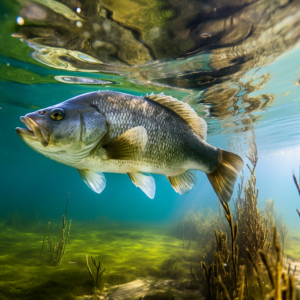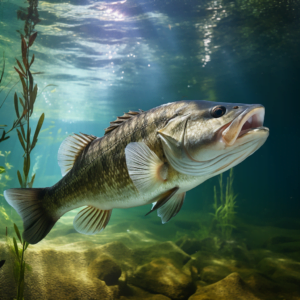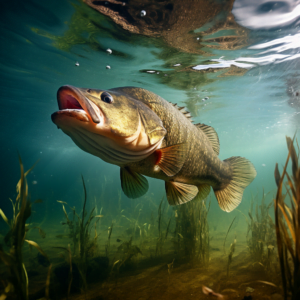So, you’re interested in learning about largemouth bass, huh? Well, let me tell you, these fish are quite fascinating creatures! Did you know that there are actually two types of largemouth bass? Yes, you heard that right! In this article, we’re going to dive deeper into understanding these two types and how they differ from each other. By the end, you’ll be a bona fide largemouth bass expert!
The two types of largemouth bass are the northern largemouth bass (Micropterus salmoides salmoides) and the Florida largemouth bass (Micropterus salmoides floridensis). Each type has its own unique characteristics and can be found in different regions. The northern largemouth bass is more commonly found in the northern parts of the United States and Canada, while the Florida largemouth bass is found in, well, you guessed it, Florida!
Now, here’s the interesting part – the Florida largemouth bass is known to grow much larger than its northern counterpart. In fact, it holds the world record for the largest largemouth bass ever caught, weighing in at a whopping 22 pounds! The northern largemouth bass, on the other hand, usually reaches a maximum weight of around 10 pounds. Impressive, right?
If you’re eager to learn more about these fascinating fish, stay tuned for the rest of the article, where we’ll take a closer look at their appearance, behavior, and much more. You won’t want to miss it!
Understanding the Types of Largemouth Bass
The largemouth bass, a popular game fish found in North America, is known for its impressive size and ability to put up a fight when caught. While many anglers may be familiar with the species as a whole, there are actually two distinct types of largemouth bass: the smallmouth bass and the largemouth bass. In this article, we will explore the differences between these two types, as well as delve into the various aspects of largemouth bass, including their physical characteristics, habitat, feeding habits, reproduction cycle, behavioral patterns, and their importance in the ecosystem. Additionally, we will provide some tips for catching largemouth bass and discuss the importance of conservation efforts aimed at preserving this remarkable species.
Differentiating Smallmouth and Largemouth Bass
When it comes to distinguishing between smallmouth and largemouth bass, one of the key differences lies in their appearance. Largemouth bass, as the name suggests, have a larger mouth compared to smallmouth bass. The upper jaw of the largemouth bass extends beyond the eye, whereas the upper jaw of the smallmouth bass only reaches to the middle of the eye. This difference in jaw length gives the largemouth bass a distinct advantage when it comes to swallowing prey. Furthermore, while both types of bass have a greenish coloration, the smallmouth bass typically has vertical bars or markings along its body, whereas the largemouth bass usually has a solid green or blackish coloration.
Identifying the Physical Characteristics of Largemouth Bass
Largemouth bass are known for their impressive size and robust physique. On average, adult largemouth bass can reach lengths of 15-20 inches and weigh between 2-8 pounds. However, there have been reports of largemouth bass exceeding 10 pounds, making them a highly sought-after trophy fish among anglers. In terms of physical features, the largemouth bass has a broad head and a muscular body. Their dorsal fin is long and continuous, which runs along the back of the fish. Additionally, they have sharp teeth designed to capture and hold onto their prey, which mainly consists of smaller fish, frogs, crayfish, and even small mammals like mice and baby ducks.
Analyzing the Habitat of Largemouth Bass
Largemouth bass can be found in a wide range of habitats throughout North America, including lakes, ponds, rivers, and reservoirs. They tend to prefer freshwater bodies with abundant vegetation, such as submerged grasses, lily pads, and fallen trees. These structures provide excellent hiding spots for the bass, allowing them to ambush their prey. Additionally, largemouth bass thrive in warm water temperatures, typically between 65-80 degrees Fahrenheit. Warmer waters increase their metabolism and activity levels, making them more likely to engage in feeding behavior.
Examining the Feeding Habits of Largemouth Bass
Largemouth bass are voracious predators and are known for their aggressive feeding habits. They are opportunistic feeders, meaning they will consume any prey that is readily available and fits within their mouth. As mentioned earlier, their diet primarily consists of smaller fish, such as minnows, shiners, and sunfish. However, they are also known to feed on insects, crustaceans, and even small mammals, depending on their size. Largemouth bass have a remarkable ability to strike at their prey with lightning speed, using their powerful jaws and sharp teeth to capture and swallow their quarry.
Understanding the Reproduction Cycle of Largemouth Bass
The reproduction cycle of largemouth bass plays a crucial role in maintaining healthy populations of this species. Typically, largemouth bass spawn during the spring season when water temperatures start to rise. The female bass lays her eggs in shallow nests or depressions that she creates in the substrate, often near aquatic vegetation or structure. After the eggs are fertilized by the male bass, the female guards the nest, fiercely protecting it from potential predators. The eggs usually hatch within a week, and the newborn bass, known as fry, rely on their yolk sacs for nourishment until they are able to feed on their own. It is worth noting that largemouth bass have a relatively slow growth rate, with males reaching sexual maturity around the age of two while females take slightly longer.
Exploring the Behavioral Patterns of Largemouth Bass
Largemouth bass exhibit unique behavioral patterns that have fascinated anglers and researchers alike. They are typically solitary creatures, preferring to hunt and feed individually rather than in groups. However, during the spawning season, largemouth bass may form temporary pairs or small groups around the nesting areas. Additionally, largemouth bass are known to be territorial, fiercely defending their preferred hunting grounds and nesting areas from intruders. They also exhibit an interesting habit known as “bedding,” where the male creates a circular depression on the lake or river bottom to attract a female for spawning. This behavior can often be observed when the water is clear and the bass are shallow.
The Importance of Largemouth Bass in the Ecosystem
Largemouth bass play a vital role in the ecosystem as both predators and prey. As predators, they help regulate the populations of smaller fish species and control the balance of the aquatic food chain. They also serve as indicators of a healthy ecosystem since their presence indicates the availability of suitable habitat and food sources. Additionally, largemouth bass are highly prized by anglers, contributing to the economic value of recreational fishing. The sport of bass fishing generates significant revenue through equipment sales, tournaments, and tourism, benefiting local communities and economies.
Tips for Catching Largemouth Bass
If you’re interested in catching largemouth bass, there are a few tips that can increase your chances of a successful fishing trip. First and foremost, it is essential to understand the behavioral patterns of largemouth bass, including their preferred habitat, feeding habits, and spawning season. Armed with this knowledge, you can select appropriate lures and bait that mimic the natural prey of the bass. Soft plastic worms, crankbaits, and topwater lures are all popular choices among bass anglers. Additionally, employing techniques such as casting near structure, using a slow retrieve, or imitating injured or wounded prey can be effective in enticing largemouth bass to strike.
Conservation Efforts for Largemouth Bass
Conservation efforts are crucial in maintaining healthy populations of largemouth bass and ensuring the long-term sustainability of this species. Fisheries management agencies and organizations work diligently to preserve and enhance bass habitats, enforce and regulate fishing regulations, and promote catch-and-release practices. It is important for anglers and recreational fishermen to follow size and bag limits, practice proper handling techniques when releasing caught fish, and be mindful of the impact they have on the environment. By practicing responsible fishing and supporting conservation efforts, we can all contribute to the preservation of largemouth bass populations for future generations to enjoy.
Conclusion
In conclusion, understanding the types of largemouth bass is essential for both anglers and enthusiasts. Differentiating between smallmouth and largemouth bass can be done through careful observation of physical characteristics. The largemouth bass boasts impressive size and strength, along with a unique feeding habit and distinct behavioral patterns. Their significance in the ecosystem cannot be overstated, as they play a vital role in maintaining a balanced aquatic environment. By following proper fishing techniques and supporting conservation efforts, we can ensure the survival and prosperity of largemouth bass for years to come. So, next time you cast your line, remember to appreciate these magnificent creatures and the joy they bring to the world of fishing.




